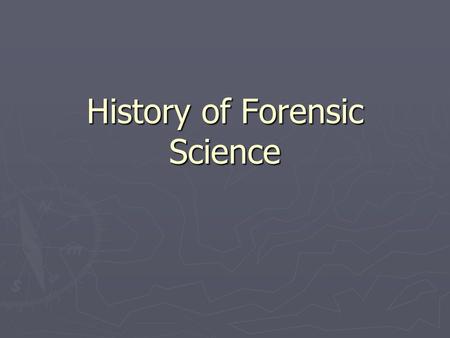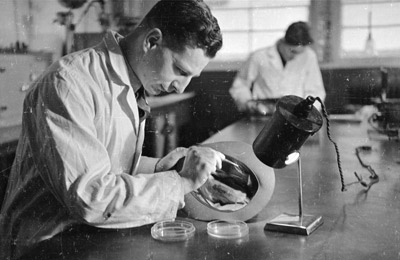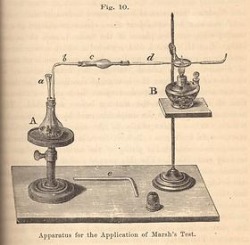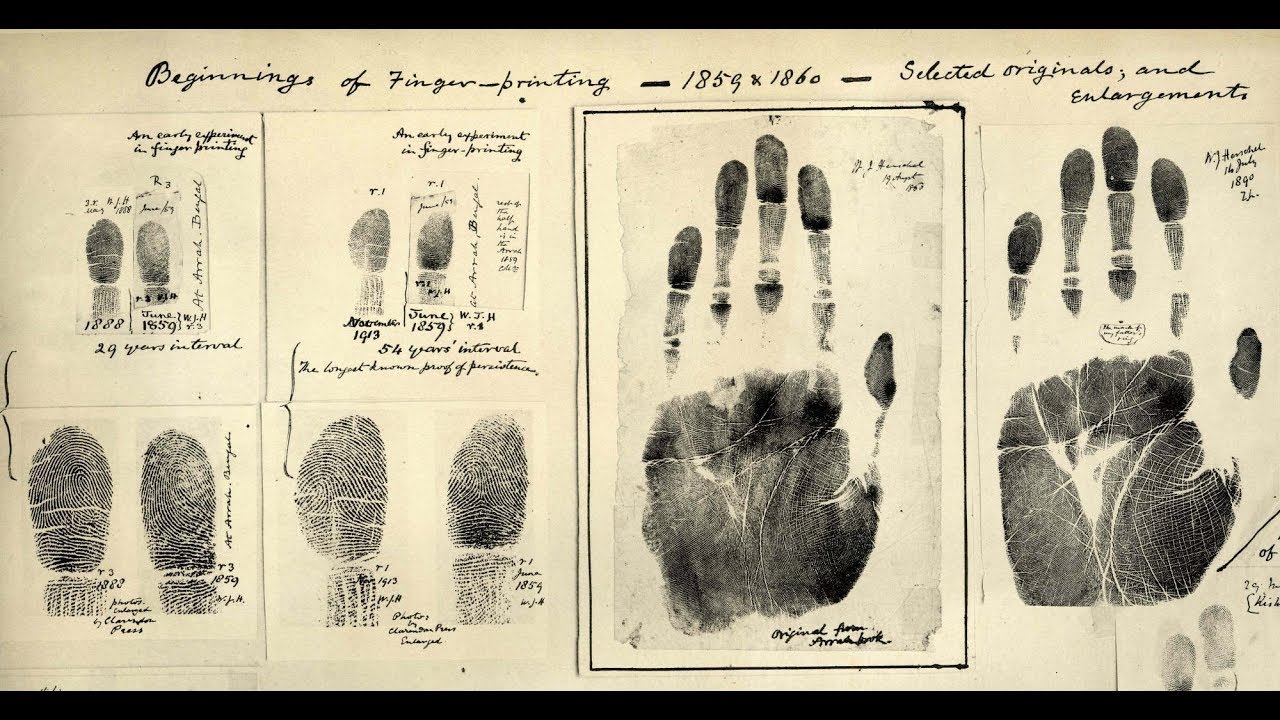 History Of Forensic
Computer Forensics
Forensics Sciences
History Of Forensic
Computer Forensics
Forensics Sciences
History
The history of forensic science dates back thousands of years. Fingerprinting was one of its first applications. The ancient Chinese used fingerprints to identify business documents. In 1892, a eugenicist (an adherent of the often prejudiced system of scientific classification) named Sir Francis Galton established the first system for classifying fingerprints. Sir Edward Henry, commissioner of the Metropolitan Police of London, developed his own system in 1896 based on the direction, flow, pattern and other characteristics in fingerprints. The Henry Classification System became the standard for criminal fingerprinting techniques worldwide.
In 1835, Scotland Yard's Henry Goddard became the first person to use physical analysis to connect a bullet to the murder weapon. Bullet examination became more precise in the 1920s, when American physician Calvin Goddard created the comparison microscope to help determine which bullets came from which shell casings. And in the 1970s, a team of scientists at the Aerospace Corporation in California developed a method for detecting gunshot residue using scanning electron microscopes.
Forensic Lab Safety
The job of a forensic scientist involves using a variety of chemicals, which can be flammable, corrosive and even explosive if not handled properly. Here are a few tips that forensic labs follow to ensure that their employees stay safe:
Labs should have procedures in place for the use and disposal of chemicals, as well as a safety plan in case of emergency (including a safety shower and eyewash station).
Employees need to be well-trained in the use of all chemicals, understanding the properties of each chemical and its potential to cause injury.
Lab technicians should wear the proper gear eyewear to protect against chemical splashes and gloves to protect their hands.
Chemical containers should be properly labeled with the correct chemical name.
Flammable liquids should always be kept in special storage containers or a storage room. Putting these types of chemicals in a regular refrigerator can lead to an explosion.
In 1836, a Scottish chemist named James Marsh developed a chemical test to detect arsenic, which was used during a murder trial. Nearly a century later, in 1930, scientist Karl Landsteiner won the Nobel Prize for classifying human blood into its various groups. His work paved the way for the future use of blood in criminal investigations. Other tests were developed in the mid-1900s to analyze saliva, semen and other body fluids as well as to make blood tests more precise.
With all of the new forensics techniques emerging in the early 20th century, law enforcement discovered that it needed a specialized team to analyze evidence found at crime scenes. To that end, Edmond Locard, a professor at the University of Lyons, set up the first police crime laboratory in France in 1910. For his pioneering work in forensic criminology, Locard became known as "the Sherlock Holmes of France."
August Vollmer, chief of the Los Angeles Police, established the first American police crime laboratory in 1924. When the Federal Bureau of Investigation (FBI) was first founded in 1908, it didn't have its own forensic crime laboratory -- that wasn't set up until 1932.
By the close of the 20th century, forensic scientists had a wealth of high-tech tools at their disposal for analyzing evidence from polymerase chain reaction (PCR) for DNA analysis, to digital fingerprinting techniques with computer search capabilities.
Nearly a century later, in 1930, scientist Karl Landsteiner won the Nobel Prize for classifying human blood into its various groups. His work paved the way for the future use of blood in criminal investigations. Other tests were developed in the mid-1900s to analyze saliva, semen and other body fluids as well as to make blood tests more precise.
With all of the new forensics techniques emerging in the early 20th century, law enforcement discovered that it needed a specialized team to analyze evidence found at crime scenes. To that end, Edmond Locard, a professor at the University of Lyons, set up the first police crime laboratory in France in 1910. For his pioneering work in forensic criminology, Locard became known as "the Sherlock Holmes of France."
August Vollmer, chief of the Los Angeles Police, established the first American police crime laboratory in 1924. When the Federal Bureau of Investigation (FBI) was first founded in 1908, it didn't have its own forensic crime laboratory -- that wasn't set up until 1932.
By the close of the 20th century, forensic scientists had a wealth of high-tech tools at their disposal for analyzing evidence from polymerase chain reaction (PCR) for DNA analysis, to digital fingerprinting techniques with computer search capabilities.
Development of the science through ages
In the beginning of the 19th century, natural sciences began to develop rapidly. Justice was always in search of impartial evidence, as against testimony of unwilling, hostile, indifferent witnesses. At the same time , Sir Arthur Conan Doyle , through his fictional character Sherlock Holmes popularized scientific crime detection methods. This help publicize amongst scientists and investigators that science could aid in criminal detection. most pioneering work originated in Europe. many can be cited as contributors in building the foundation.
MATHIEU ORFILA: Father of modern toxicology. In the early part of the 19th century he established in Paris methods of scientific chemical analysis of poisons , which are in use even today.
ALPHONSE BERTILLON:
of France was 1st to evolve a scientific system of personal identification. in 1879 he developed the science of ANTHROPOMETRY, a systemic procedure of taking a series of body measurements to facilitate distinguishing one individual from another. With the invention of photography he was the first to use it in criminal investigation. IN 1881 , he began to take standard pictures of all French criminals and file them in the Bureau of Identification than in Paris. His efforts have earned him the distinction of being known as the Father of Criminal Investigation.
FRANCIS GALTON:
Father of modern toxicology. In the early part of the 19th century he established in Paris methods of scientific chemical analysis of poisons , which are in use even today.
ALPHONSE BERTILLON:
of France was 1st to evolve a scientific system of personal identification. in 1879 he developed the science of ANTHROPOMETRY, a systemic procedure of taking a series of body measurements to facilitate distinguishing one individual from another. With the invention of photography he was the first to use it in criminal investigation. IN 1881 , he began to take standard pictures of all French criminals and file them in the Bureau of Identification than in Paris. His efforts have earned him the distinction of being known as the Father of Criminal Investigation.
FRANCIS GALTON: of U.K. undertook the first systemic study of fingerprints. He developed a methodology of classifying the fingerprints for filing purposes .in 1892, he published a book on fingerprints giving a sound statistical proof of uniqueness of individualization through fingerprints.
HANS GROSS:
of Austria, a lawyer by profession, spent many years studying the principles of criminal investigation. He published a book on criminal investigation (later published in English) , a classic in 1893 , 'Handbuch fur Untersuchnugsrichter'.
EDMOND LOCARD:
in 1910 established a police laboratory in Lyons and later founded the Institute of Criminalistics at the University of Lyons. he propounded the famous PRINCIPLE OF EXCHANGE , which forms the basis of forensic examination of physical evidence.
KARL LANDSTEINER:
in 1901 discovered that blood could be grouped into different categories. Following this Dr. Leone Lattes of Italy devised a relatively simple procedure for determining the blood group of dried bloodstains and immediately adopted this technique for criminal investigation.
CALVIN GODDARD:
a U.S. army colonel perfected the science of ballistics . He developed a comparison microscope for comparison of crime and test fired bullets to determine whether or not a particular weapon was used in the offence.
ALBERT OSBORN:
developed fundamental principles of document examination, which gave acceptance to documents as scientific evidence by the courts. in 1910 he wrote the classic QUESTIONED DOCUMENTS which is primary book of reference for document experts.
During the post World War I period, Locard's successes in the application of scientific methods in criminal investigation served as a impetus for formation of police labs in Berlin, Vienna , Sweden , Finland and Holland . This was followed by formation of a forensic lab in Los Angeles Police Department in USA in 1923. In 1932, FBI organised a national lab ,which offered forensic services to all the law enforcement agencies in USA by establishing Metropolitan Forensic Sciences Laboratory at Scotland Yard in 1935.
After World War II there was a sudden spurt in crime rate due to large scale availability of firearms. further, due to mobility an documentation organised and white collar crime proliferated. Western countries had to mobilize scientific aids to combat the growing menace.
Today U.S. alone has about 250 labs . A small country as UK established 11 more regional labs in different parts. another development was the creation of central research establishment in Aldermaston in 1966 , wholly devoted to basic research in forensic science. Japan has a huge national research institute of forensic science in Tokyo and several regional labs. west Germany set up over 21 forensic labs . Italy 13 , France 4 , Canada 7 and Switzerland 4 .
There are as many as 1100 forensic science laboratories in 89 countries.
of U.K. undertook the first systemic study of fingerprints. He developed a methodology of classifying the fingerprints for filing purposes .in 1892, he published a book on fingerprints giving a sound statistical proof of uniqueness of individualization through fingerprints.
HANS GROSS:
of Austria, a lawyer by profession, spent many years studying the principles of criminal investigation. He published a book on criminal investigation (later published in English) , a classic in 1893 , 'Handbuch fur Untersuchnugsrichter'.
EDMOND LOCARD:
in 1910 established a police laboratory in Lyons and later founded the Institute of Criminalistics at the University of Lyons. he propounded the famous PRINCIPLE OF EXCHANGE , which forms the basis of forensic examination of physical evidence.
KARL LANDSTEINER:
in 1901 discovered that blood could be grouped into different categories. Following this Dr. Leone Lattes of Italy devised a relatively simple procedure for determining the blood group of dried bloodstains and immediately adopted this technique for criminal investigation.
CALVIN GODDARD:
a U.S. army colonel perfected the science of ballistics . He developed a comparison microscope for comparison of crime and test fired bullets to determine whether or not a particular weapon was used in the offence.
ALBERT OSBORN:
developed fundamental principles of document examination, which gave acceptance to documents as scientific evidence by the courts. in 1910 he wrote the classic QUESTIONED DOCUMENTS which is primary book of reference for document experts.
During the post World War I period, Locard's successes in the application of scientific methods in criminal investigation served as a impetus for formation of police labs in Berlin, Vienna , Sweden , Finland and Holland . This was followed by formation of a forensic lab in Los Angeles Police Department in USA in 1923. In 1932, FBI organised a national lab ,which offered forensic services to all the law enforcement agencies in USA by establishing Metropolitan Forensic Sciences Laboratory at Scotland Yard in 1935.
After World War II there was a sudden spurt in crime rate due to large scale availability of firearms. further, due to mobility an documentation organised and white collar crime proliferated. Western countries had to mobilize scientific aids to combat the growing menace.
Today U.S. alone has about 250 labs . A small country as UK established 11 more regional labs in different parts. another development was the creation of central research establishment in Aldermaston in 1966 , wholly devoted to basic research in forensic science. Japan has a huge national research institute of forensic science in Tokyo and several regional labs. west Germany set up over 21 forensic labs . Italy 13 , France 4 , Canada 7 and Switzerland 4 .
There are as many as 1100 forensic science laboratories in 89 countries.
 Nearly a century later, in 1930, scientist Karl Landsteiner won the Nobel Prize for classifying human blood into its various groups. His work paved the way for the future use of blood in criminal investigations. Other tests were developed in the mid-1900s to analyze saliva, semen and other body fluids as well as to make blood tests more precise.
With all of the new forensics techniques emerging in the early 20th century, law enforcement discovered that it needed a specialized team to analyze evidence found at crime scenes. To that end, Edmond Locard, a professor at the University of Lyons, set up the first police crime laboratory in France in 1910. For his pioneering work in forensic criminology, Locard became known as "the Sherlock Holmes of France."
August Vollmer, chief of the Los Angeles Police, established the first American police crime laboratory in 1924. When the Federal Bureau of Investigation (FBI) was first founded in 1908, it didn't have its own forensic crime laboratory -- that wasn't set up until 1932.
By the close of the 20th century, forensic scientists had a wealth of high-tech tools at their disposal for analyzing evidence from polymerase chain reaction (PCR) for DNA analysis, to digital fingerprinting techniques with computer search capabilities.
Nearly a century later, in 1930, scientist Karl Landsteiner won the Nobel Prize for classifying human blood into its various groups. His work paved the way for the future use of blood in criminal investigations. Other tests were developed in the mid-1900s to analyze saliva, semen and other body fluids as well as to make blood tests more precise.
With all of the new forensics techniques emerging in the early 20th century, law enforcement discovered that it needed a specialized team to analyze evidence found at crime scenes. To that end, Edmond Locard, a professor at the University of Lyons, set up the first police crime laboratory in France in 1910. For his pioneering work in forensic criminology, Locard became known as "the Sherlock Holmes of France."
August Vollmer, chief of the Los Angeles Police, established the first American police crime laboratory in 1924. When the Federal Bureau of Investigation (FBI) was first founded in 1908, it didn't have its own forensic crime laboratory -- that wasn't set up until 1932.
By the close of the 20th century, forensic scientists had a wealth of high-tech tools at their disposal for analyzing evidence from polymerase chain reaction (PCR) for DNA analysis, to digital fingerprinting techniques with computer search capabilities.
 History Of Forensic
Computer Forensics
Forensics Sciences
History Of Forensic
Computer Forensics
Forensics Sciences
 Father of modern toxicology. In the early part of the 19th century he established in Paris methods of scientific chemical analysis of poisons , which are in use even today.
ALPHONSE BERTILLON:
of France was 1st to evolve a scientific system of personal identification. in 1879 he developed the science of ANTHROPOMETRY, a systemic procedure of taking a series of body measurements to facilitate distinguishing one individual from another. With the invention of photography he was the first to use it in criminal investigation. IN 1881 , he began to take standard pictures of all French criminals and file them in the Bureau of Identification than in Paris. His efforts have earned him the distinction of being known as the Father of Criminal Investigation.
FRANCIS GALTON:
Father of modern toxicology. In the early part of the 19th century he established in Paris methods of scientific chemical analysis of poisons , which are in use even today.
ALPHONSE BERTILLON:
of France was 1st to evolve a scientific system of personal identification. in 1879 he developed the science of ANTHROPOMETRY, a systemic procedure of taking a series of body measurements to facilitate distinguishing one individual from another. With the invention of photography he was the first to use it in criminal investigation. IN 1881 , he began to take standard pictures of all French criminals and file them in the Bureau of Identification than in Paris. His efforts have earned him the distinction of being known as the Father of Criminal Investigation.
FRANCIS GALTON: of U.K. undertook the first systemic study of fingerprints. He developed a methodology of classifying the fingerprints for filing purposes .in 1892, he published a book on fingerprints giving a sound statistical proof of uniqueness of individualization through fingerprints.
HANS GROSS:
of Austria, a lawyer by profession, spent many years studying the principles of criminal investigation. He published a book on criminal investigation (later published in English) , a classic in 1893 , 'Handbuch fur Untersuchnugsrichter'.
EDMOND LOCARD:
in 1910 established a police laboratory in Lyons and later founded the Institute of Criminalistics at the University of Lyons. he propounded the famous PRINCIPLE OF EXCHANGE , which forms the basis of forensic examination of physical evidence.
KARL LANDSTEINER:
in 1901 discovered that blood could be grouped into different categories. Following this Dr. Leone Lattes of Italy devised a relatively simple procedure for determining the blood group of dried bloodstains and immediately adopted this technique for criminal investigation.
CALVIN GODDARD:
a U.S. army colonel perfected the science of ballistics . He developed a comparison microscope for comparison of crime and test fired bullets to determine whether or not a particular weapon was used in the offence.
ALBERT OSBORN:
developed fundamental principles of document examination, which gave acceptance to documents as scientific evidence by the courts. in 1910 he wrote the classic QUESTIONED DOCUMENTS which is primary book of reference for document experts.
During the post World War I period, Locard's successes in the application of scientific methods in criminal investigation served as a impetus for formation of police labs in Berlin, Vienna , Sweden , Finland and Holland . This was followed by formation of a forensic lab in Los Angeles Police Department in USA in 1923. In 1932, FBI organised a national lab ,which offered forensic services to all the law enforcement agencies in USA by establishing Metropolitan Forensic Sciences Laboratory at Scotland Yard in 1935.
After World War II there was a sudden spurt in crime rate due to large scale availability of firearms. further, due to mobility an documentation organised and white collar crime proliferated. Western countries had to mobilize scientific aids to combat the growing menace.
Today U.S. alone has about 250 labs . A small country as UK established 11 more regional labs in different parts. another development was the creation of central research establishment in Aldermaston in 1966 , wholly devoted to basic research in forensic science. Japan has a huge national research institute of forensic science in Tokyo and several regional labs. west Germany set up over 21 forensic labs . Italy 13 , France 4 , Canada 7 and Switzerland 4 .
There are as many as 1100 forensic science laboratories in 89 countries.
of U.K. undertook the first systemic study of fingerprints. He developed a methodology of classifying the fingerprints for filing purposes .in 1892, he published a book on fingerprints giving a sound statistical proof of uniqueness of individualization through fingerprints.
HANS GROSS:
of Austria, a lawyer by profession, spent many years studying the principles of criminal investigation. He published a book on criminal investigation (later published in English) , a classic in 1893 , 'Handbuch fur Untersuchnugsrichter'.
EDMOND LOCARD:
in 1910 established a police laboratory in Lyons and later founded the Institute of Criminalistics at the University of Lyons. he propounded the famous PRINCIPLE OF EXCHANGE , which forms the basis of forensic examination of physical evidence.
KARL LANDSTEINER:
in 1901 discovered that blood could be grouped into different categories. Following this Dr. Leone Lattes of Italy devised a relatively simple procedure for determining the blood group of dried bloodstains and immediately adopted this technique for criminal investigation.
CALVIN GODDARD:
a U.S. army colonel perfected the science of ballistics . He developed a comparison microscope for comparison of crime and test fired bullets to determine whether or not a particular weapon was used in the offence.
ALBERT OSBORN:
developed fundamental principles of document examination, which gave acceptance to documents as scientific evidence by the courts. in 1910 he wrote the classic QUESTIONED DOCUMENTS which is primary book of reference for document experts.
During the post World War I period, Locard's successes in the application of scientific methods in criminal investigation served as a impetus for formation of police labs in Berlin, Vienna , Sweden , Finland and Holland . This was followed by formation of a forensic lab in Los Angeles Police Department in USA in 1923. In 1932, FBI organised a national lab ,which offered forensic services to all the law enforcement agencies in USA by establishing Metropolitan Forensic Sciences Laboratory at Scotland Yard in 1935.
After World War II there was a sudden spurt in crime rate due to large scale availability of firearms. further, due to mobility an documentation organised and white collar crime proliferated. Western countries had to mobilize scientific aids to combat the growing menace.
Today U.S. alone has about 250 labs . A small country as UK established 11 more regional labs in different parts. another development was the creation of central research establishment in Aldermaston in 1966 , wholly devoted to basic research in forensic science. Japan has a huge national research institute of forensic science in Tokyo and several regional labs. west Germany set up over 21 forensic labs . Italy 13 , France 4 , Canada 7 and Switzerland 4 .
There are as many as 1100 forensic science laboratories in 89 countries.